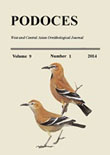فهرست مطالب

Podoces
Volume:9 Issue: 1, 2014
- تاریخ انتشار: 1393/03/13
- تعداد عناوین: 3
-
Pages 1-6The breeding performance of the Red-vented Bulbul Pycnonotus cafer was studied at the Tehsil Mansehra, KP Province of Pakistan during the breeding season from May to August 2013. Pair formation in Red-vented Bulbul occurred in March and April, followed by nest construction. During the breeding season 37 nests were observed with 88 eggs. The Red-vented Bulbul preferred leafy, dense shrubs and smaller trees for nest construction. Average plant and nest height was 2.2±0.2 and 1.9±0.3m, respectively. Mean clutch size was 2.3 ranged 1–3. Egg length and breadth was 20.2±0.6 and 16.0±0.6mm. Egg volume and Egg shape index was 2.6±0.2cm3 and 1.24±0.02. There was significant correlation found between egg length and breadth in relation to clutch size (P<0.05). Egg success was 55.6% and nest success was 59.4%. Main reasons for breeding failures were unhatched eggs, weather conditions and observer’s disturbance. Average fledgling produced per nest was 2.2.Keywords: Breeding, Mansehra, Pakistan, Pycnonotus cafer, Red, vented Bulbul
-
Pages 7-21During five stays in Iran, the author collected remnants of the diet from seven species of owls. The most numerous were samples from the Eurasian Eagle Owl Bubo bubo, which were found in 38 sites, usually on rocky cliffs where the owls breed or where they roost during the day. A total of 7,862 items of prey were analysed. Mammals predominated (Mammalia, 56 species, 77.0%), and the species representation of birds was diverse (Aves, more than 100 species, 15.3%); lower vertebrates were hunted less often (Amphibia, Reptilia, Pisces, 5.0%), while invertebrates (Evertebrata, 2.7%) were an occasional food supplement. The most commonly represented rodents (Rodentia) in the Elborz and Talysh Mountains were: Snow Vole Chionomys nivalis, Steppe Field Mouse Apodemus witherbyi and Common Vole Microtus obscurus; in the northern part of the Zagros Mountains: Brandt’s Hamster Mesocricetus brandti, Williams’ Jerboa Allactaga williamsi and Setzer’s Mouse-tailed Dormouse Myomimus setzeri; in the central wetter part of the Zagros: Persian Jird Meriones persicus, Tristam’s Jird Meriones tristrami, Transcaucasian Mole Vole Ellobius lutescens and Grey Hamster Cricetulus migratorius; in the drier part of the Zagros: Libyan Jird Meriones libycus, Sundevall’s Jird Meriones crassus and Indian Gerbil Tatera indica; in the southern part of the Zagros in Fars Province: Iranian Vole Microtus irani, the rats Rattus rattus and R. norvegicus and mice Mus sp.; in the southeastern part of Iran: Short-tailed Bandicoot Rat Nesokia indica; and in the Koppeh Dagh Mountains: Southern Mole Vole Ellobius fuscocapillus, Afghan Vole Microtus afghanus, Midday Jird Meriones meridianus and Small Five-toed Jerboa Allactaga elater. Analysis of diet samples from the Eurasian Eagle Owl from the northern Zagros Mountains and eastern Turkey showed that Setzer’s Mouse-tailed Dormouse Myomimus setzeri occured only in samples from locations above 1800 m a.s.l., where Brandt’s Hamster Mesocricetus brandti was the predominant prey.Keywords: Eurasian Eagle Owl, Bubo bubo, Diet, Iran
-
Pages 22-30Oil contains several heavy metals such as vanadium, which in high concentrations have adverse effects on animal breeding, physiology and their behaviour. Marine birds and sediments which are known as sentinel species and metal reservoir respectively are appropriate indicators of pollutions in marine ecosystems. This survey was conducted in July 2012. Objectives of the study were to examine the concentrations of Vanadium in randomly collected eggs of three breeding tern species and sediments on Shidvar and Bani Farour Islands, in the Persian Gulf; to survey the suitability of terns eggs as a biomonitoring agent. The highest mean of Vanadium level of egg contents and eggshells were found in Bridled Tern from Shidvar Island. The comparison between the same species from these islands indicated that the mean Vanadium level in the White-cheeked Tern and Bridled Tern on Bani Farour Island were more than Shidvar Island while the average was, in contrast, more for the Lesser Crested Tern nesting on Shidvar Island. There was significant difference between concentrations of Vanadium in sediments of these two islands (p<0.01). Although most Vanadium levels in eggs were lower than FSNZ and WHO standards, and the rates in sediments were lower than RSA standard, the relative coordination between concentrations of Vanadium in eggs and sediments in the present study shows that tern eggs represent the pollution status of studying areas as a proper biomonitoring agent.Keywords: Vanadium, Tern egg, Shidvar Island, Bani Farour Island, Persian Gulf, Waterbirds

